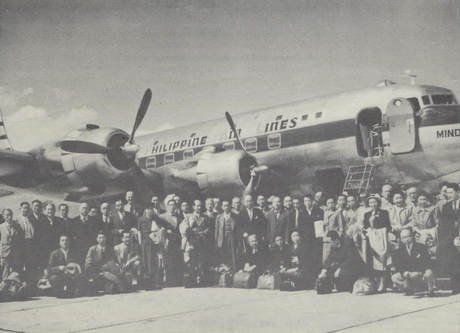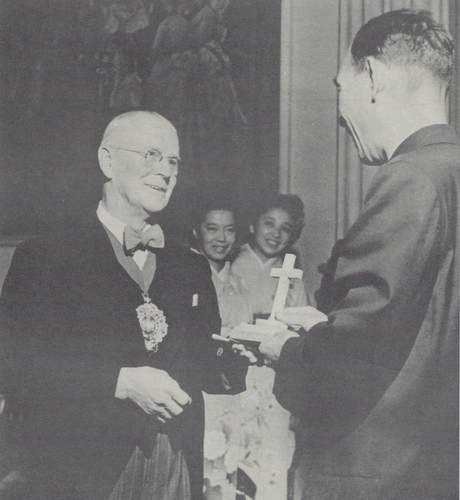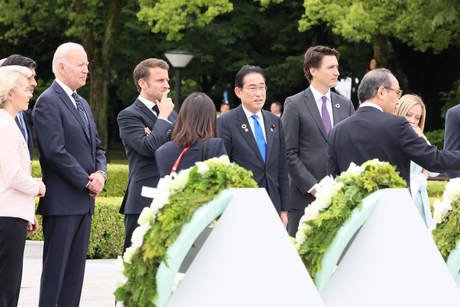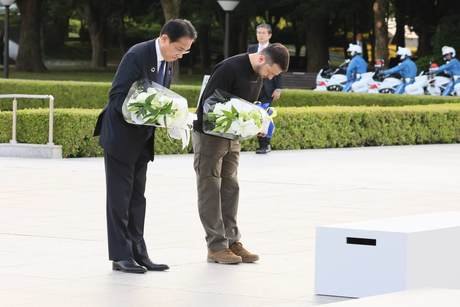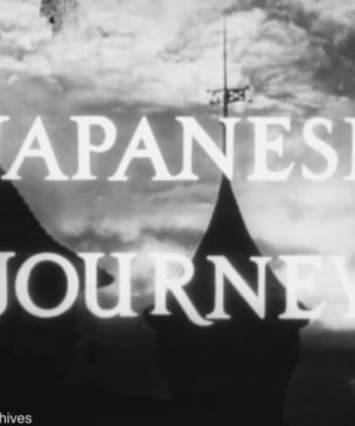The inscription on the cenotaph at the Hiroshima Peace Park says in Japanese, “Sleep in peace. We shall not make the same mistake again.” The inspiration for this wording began when Hiroshima Mayor Shinzo Hamai witnessed dramatic reconciliations between Germans and French at the Moral Re-Armament (now Initiatives of Change) conference centre at Caux, Switzerland in 1950. This profound message is as valid today as it was then.
He was part of a group of about 70 Japanese political, business and labour leaders. Japan was under Allied occupation, and this was the first large group allowed to leave the country after the war, with the permission of General MacArthur. The delegation included seven members of parliament and the Governors and Mayors of Hiroshima and Nagasaki where the two atomic bombs were dropped.
Dr Frank Buchman, the initiator of MRA and hundreds of participants welcomed the Japanese. An international chorus sang a song in Japanese and the Japanese flag was raised which was not allowed inside Japan.
Daiji Ioka, a labour union leader, said, “Our nation took a road to war which caused tremendous suffering to the world. We fully expected to be treated as enemies, but we were given a warm welcome.” Mayor Hamai said, “No one was blamed for any wrongdoing. Here, there were only the words, ‘Sorry’, ‘I was wrong’ and ‘Thank you.’”
While they were at Caux, North Korea invaded South Korea and full-scale war started. This made some in the delegation feel they should return home, but eventually all of them decided to continue their journey. From Caux, they went to both the victorious and defeated nations in the West. They met Pope Pius XⅡ, German Chancellor Konrad Adenauer, French Foreign Minister Robert Schuman, in London, Lord Mayor Rowland, and many political and civil society leaders. Mayor Hamai presented a number of crosses, carved from a 400-year-old camphor tree that was blasted by the atomic bomb.
At the United States Senate, Japanese Member of Parliament Chojiro Kuriyama representing Prime Minister Shigeru Yoshida spoke. “It is our sincere regret that Japan has broken an almost century-old friendship between our two countries. In spite of this big mistake, the magnanimous forgiveness and generosity of America not only allowed Japan to survive but is helping her recovery,” he said. The New York Times noted: “A little less than five years after the atomic bombs fell on Hiroshima and Nagasaki … the Mayors of Hiroshima and Nagasaki were among today’s visitors. If they, too, felt that they had something to forgive they had achieved that miracle.”
Mayor Hamai decided to build a memorial after a visit to the Unknown Soldier’s memorial at Arlington National Cemetery. In a radio interview by CBS Radio on August 6, the fifth Anniversary of Hiroshima Day in Los Angeles, he spoke, “The only thing we ask of the world is that everybody becomes aware of what happened in Hiroshima… and exerts every effort to see it will not have to happen again in any other place…The one dream and hope left to our surviving citizens is to re-establish the city as a pattern for peace.”
Eventually, the Hiroshima Peace Memorial Park was created in 1952. It carries the words: “Sleep in peace. We shall not make the same mistake again,” meaning that Japan as well as the U.S. was responsible. When criticized for suggesting Japan was also responsible, he replied: “I was bombed. I felt that this might be the end of the world. It was not to inquire who was responsible, but to have a strong thought that this horrible thing must never happen again.”
In May 2023, when a Summit meeting of the leaders of seven Western economies was planned in Hiroshima, I thought that the story behind the cenotaph should be told to those seven leaders, whose countries Mayor Hamai had visited in 1950. Former Foreign Minister Hirofumi Nakasone who is a son of former Prime Minister Yasuhiro Nakasone who was in the delegation to Caux in 1950 took me to meet Prime Minister Fumio Kishida just before the Summit.
In addition to explaining the story, I suggested to him that the leaders should be given the literal translation of the inscription - “We shall not make the same mistake again” – instead of the city’s official English translation “We shall not repeat the evil”. My point was that some of those G7 nations who have nuclear weapons would not like to be described as “evil”. Russian President Vladimir Putin justifies the war in Ukraine as fighting against the evil of Fascism. Eventually, when the current Mayor of Hiroshima Kazumi Matsui explained to the seven leaders about the cenotaph, a translator translated the word as “mistake” instead of “evil”.
The Prime Minister is reported to have explained the spirit behind the cenotaph on several occasions. A possible result is shown in the words President Biden wrote in the guest book at the Peace Memorial Museum, “May the stories of this Museum remind us all of our obligations to build a future of peace. Together let us continue to make progress toward the day when we can finally and forever rid the world of nuclear weapons. Keep the faith!”
The magic of Caux worked in 1950. This year this same spirit was conveyed to those seven leaders as well as those from the UN, EU, Ukraine, India, Brazil, South Korea, Indonesia, Australia, Union of the Comoros and Cook Islands who were there also. I continue to convey the spirit of Hiroshima to the world as the nuclear threat is increasing. “For A New World” can help us build a bridge between the past and the present context.
Note: for further background see the titles below under Related Content


